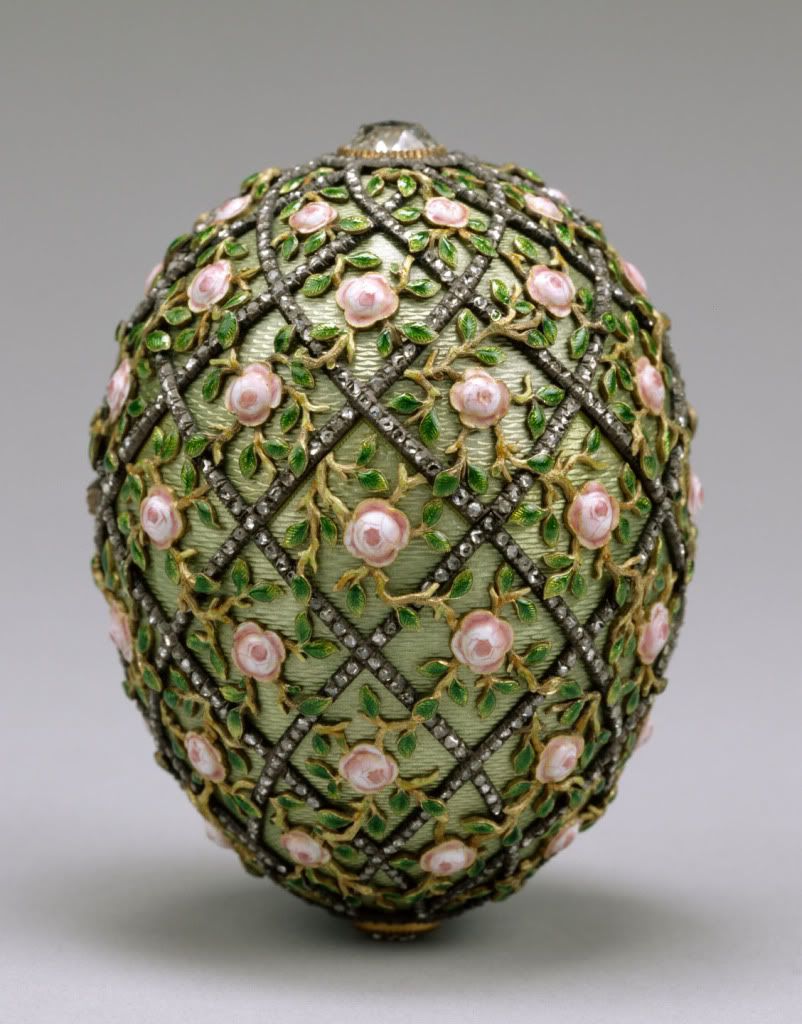 |
The Rose Trellis Fabergé Egg was acquired by
American businessman Henry Walters in 1930,
and is now at theWalters Art Museum in Baltimore.
I have re-posted below a post from last Easter Sunday. Even though Fabergé eggs are a Russian Orthodox tradition (Orthodox churches celebrate Easter next Sunday), the tradition of the egg is relevant in all Easter celebrations. I remember visiting my grandparents as a young girl on Easter day, and the best part of visit were the "chicken and egg" stews which were especially made for the day.
----------------------------------------------------------------------------------------------------
Fabergé eggs were made between 1885 and 1917, and:
[W]ere designed primarily at the behest of Russian Tsars Alexander III and Nicholas II as annual Easter gifts for Tsarinas Maria and Alexandra.This is the Easter gift that Tzar Alexander III gave Tzarina Maria Fedorovna in 1885, which also marked their twentieth wedding anniversary:
Easter is the most joyful celebration of the Orthodox faith in Russia. After the devout church services, families gather to exchange gifts of decorated eggs, symbols of renewed life and hope. The Easter of 1885 also marks the twentieth anniversary of Czar Alexander III and Czarina Maria Fedorovna, and the Czar needs an exceptional gift for his wife.Here is what the Walters Art Museum says about the (above) Rose Trellis egg:
So he places an order with a young jeweler, Peter Carl Fabergé, whose beautiful creations have recently caught Maria's eye.
On Easter morning, Fabergé delivers to the palace what appears to be a simple enameled egg. But to the delight of the Empress, inside is a golden yolk; within the yolk is a golden hen; and concealed within the hen is a diamond miniature of the royal crown and a tiny ruby egg – both now lost to history.
On April 22, 1907 [on Easter], Tsar Nicholas II presented this egg to his wife, Alexandra Fedorovna, to commemorate the birth of the tsarevich, Alexei Nicholaievich, three years earlier. Because of the Russo-Japanese War in 1904, no Imperial Easter eggs had been produced for two years. The egg contained as a surprise a diamond necklace and an ivory miniature portrait of the tsarevich framed in diamonds (now lost). Fabergé's invoice, dated April 21, 1907, listed the egg at 8,300 rubles.Many Fabergé eggs were either sold or taken out of Russia during the Russian revolution. Eight eggs are lost. Ten are now on display in the Kermlin Armory Museum. Sotheby's put up nine eggs for auction in 2004, and the entire collection went (back) to Russia, purchased by Russian oligarch Viktor Vekselberg.